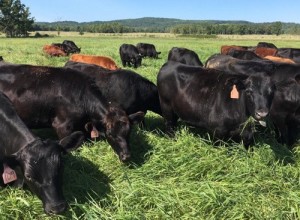By Linley Dixon, PHD – Cornucopia Institute
Almost all of the beef available in supermarkets across the country comes from sick cows that pose a significant risk to human health. The Cornucopia Institute, a national food and farm policy research group, has just released a video educating consumers on where their burger meat comes from. The informative, short video, Sick Cows/Sick People-The Grassfed Antidote, shows just how unhealthy typical beef production is and what consumers can do to find excellent meat for their Labor Day barbeques.
“Most beef cattle in the U.S. are morbidly obese and likely suffer from diabetes and fatty livers,” said Mark A. Kastel, Cornucopia’s senior farm policy analyst. “Very few would survive to old age if not sent to slaughter.”
Like people, a cow’s diet and environment strongly influences its health. The conventional U.S. beef production system depends on a network of farmers and ranchers who raise cattle on grain, with access to pasture, for the initial portion of their lives. But the final “finishing” months of a beef animal’s life is invariably spent wading through manure and mud on massive, crowded, grass-free feedlots, where thousands of other animals are fattened on GMO corn-based feed.
“These animals have evolved to eat grass and other fresh plants. High production grain-based rations, along with routinely administered drugs to promote growth and stave off the inevitable illness from their unnatural diet and living conditions, makes factory-produced animals sick,” added Cornucopia’s Kastel, who narrates the video. “Sadly, this conventional beef is what many will be grilling up on Labor Day weekend.”
But Americans don’t have to eat meat from sick animals. There is a more humane, healthy alternative: 100% grass-fed organic beef, available at your local co-op, specialty retailer, or farmers market.
While both USDA certified organic and grass-fed beef offer significant benefits compared to products produced by cows confined to a feedlot, these two labels are different. USDA certified organic cattle must be fed entirely certified organic feed, which means the pastures must be certified along with any grain and hay the cattle are fed. None of the feed, including the pastures on which the cattle graze, can be sprayed with dangerous pesticides or herbicides. In addition, organic beef cattle cannot receive antibiotics, growth-promoting hormones, or other drugs banned in organic farming.
Also, unlike conventional ruminants, organic cattle must comply with certain minimum grazing requirements. If beef carries a “100% grass-fed” label, it usually means that the cattle were fed exclusively grass, hay, and other forage. However, beef that carries a grass-fed label, but not the USDA organic seal, may receive antibiotics and hormones, and could be fed grass and forage that was sprayed with synthetic pesticides.
Consumers seek out both organic and grass-fed products because of their benefits to human health, animal welfare, and the environment. A high percentage of green forage in a beef animal’s diet imparts much higher levels of omega-3 fatty acids in the meat, and animals grazed on fresh green forage produce beef with more conjugated linoleic acids (CLA) as compared to grain-fed cows. These fatty acids have proven human health benefits. Eating grass-fed meat and dairy is among the most effective ways for humans to increase the amount of these beneficial fatty acids in their diets.
As ruminants, cattle evolved to eat mainly grass and other fresh vegetation. The microbiome in the rumen, a part of their digestive systems, excels at breaking down fiber to provide the animal with easily absorbed nutrients. Despite this, for economic reasons, most beef produced in the U.S. is grain-fed. Eating grain disrupts the normal digestive process, changing the pH in the rumen, resulting in physiological stress. This “acidosis” from grain-based diets facilitates the growth of harmful microorganisms, including dangerous strains of E. coli, and metabolic disease in animals. Feeding cattle a diet composed primarily of grass not only prevents acidosis and its associated health problems, but grazing promotes cattle’s overall physical and mental health and creates safer meat.
But consumers should be aware, greenwashing tactics are common with grass-fed labeling. A simple “grass-fed” label without any other qualifiers can just mean that the product was derived from livestock that received some portion of its diet from grass. That animal could have still received some grain, and may have been completely “finished” on grain, which negates many of the health benefits associated with prior grass feeding. However, a label with “100% grass-fed” language should close this loophole, due to basic laws regarding truthfulness in food labeling.
“One of the reasons we recommend organic certification for meat and dairy labeled ‘100% grass-fed’ is the benefit of independent, third-party oversight and federal law assuring the accuracy of the claims,” Kastel said.
“Looking for the organic seal also ensures that you know what you are getting. There is a high percentage of grass-fed meat being imported from countries that might not uphold the same high standards as the U.S. ‘100% grass-fed,’ certified organic, and locally produced is the gold standard when shopping,” Kastel added.
Consumers interested in the threefold benefits to human, environmental, and animal health and welfare, should look for beef that carries both the USDA organic seal and a 100% grass-fed label. 100% grass-fed organic beef from local farmers ensures the greatest nutrition and minimizes exposure to agrichemicals, antibiotics, and growth hormones. A cooking tip for Labor Day barbeques: 100% grass-fed beef naturally has less fat, so don’t overcook on the grill to enjoy that perfect, juicy, beefy burger taste.
Caption1 – Sick Cows
Caption2 – The Grass-fed Antidote, Meeting Place Pastures in Cornwall, VT – Photo credit- Marc Cesario







